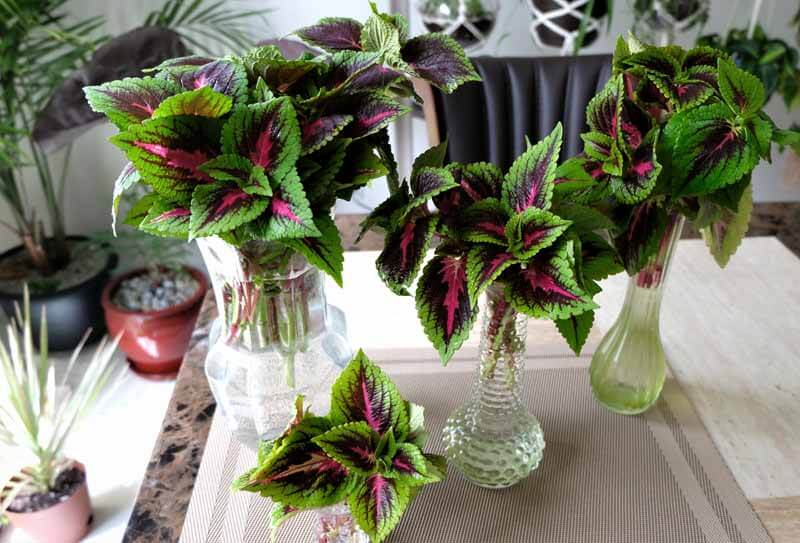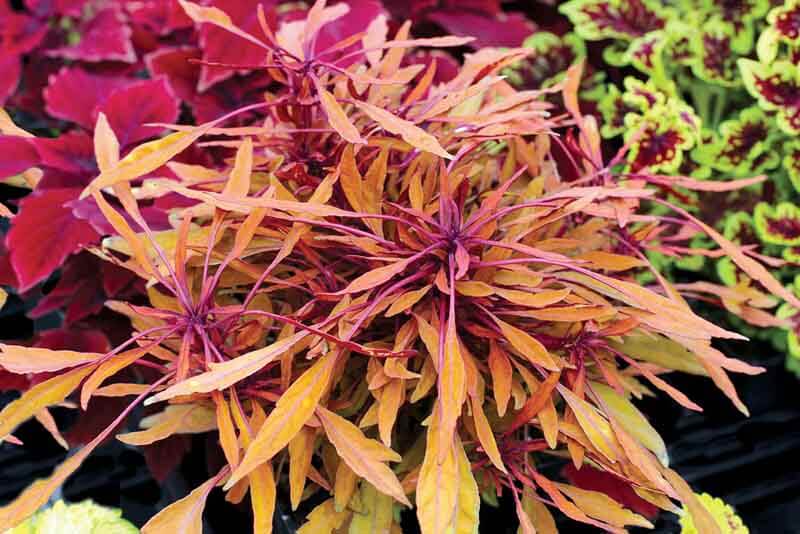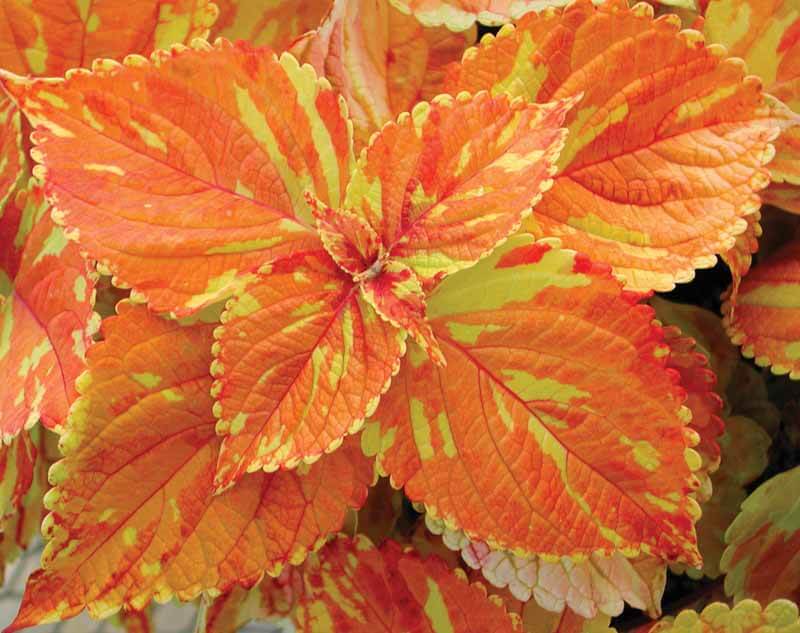
If coleus (Plectranthus scutellarioides) did not already exist, it would be necessary for gardeners to invent it. Its virtues are numerous—beautiful, easy to grow and propagate, repellent to varmints, available in endless varieties, and lovely from early spring through the first hard frost. You can even overwinter plants that you are especially fond of in the house. As if those qualities were not enough, it is also shade-loving, equally at home in beds, borders, containers, and window boxes.
Coleus Offers More for Less

When I was a beginning gardener, high on ambition and low on cash, I would pick one or two of the most beautiful or unusual coleus at the beginning of each gardening season. The minute I got the plants home, I took as many cuttings as possible and rooted them in glasses of water. Coleus is a rooting superstar; after a week to ten days, cuttings sprout roots. After another week they can be potted up.
I repeated the process through the first couple of months of the gardening season. Before the arrival of mid-summer, I had all the coleus that I needed for my containers and borders. By the time fall arrived, I had a coleus surplus that I could give away or overwinter. By overwintering and picking new varieties each year I developed a very handsome coleus collection.
Now that I am slightly more solvent, I revel in the annual cavalcade of dramatic colors, leaf shapes, and other innovations. Plant breeders have even come up with sun-tolerant coleus, like the plants in the ‘Stained Glass’ series, which is a boon for those of us who have beds that are sunny at one end and shady at the other.
Coleus Madness

So how did this plant-world prodigy find its way to our shores? Hailing from tropical areas in Southeast Asia, Africa, and Australia, coleus made its first appearance in the United States in 1851, during the Victorian era. Then as now, gardeners were mad for colorful plants, and coleus caught on. By the end of the nineteenth-century, gardeners could choose from over 150 different varieties. The colorful leaves were especially desirable for the popular carpet bedding planting schemes, where annuals were massed in designs reminiscent of the patterns found on oriental carpets.
Coleus went in and out of fashion in the twentieth century, but it is definitely back in vogue now. Like the Victorians, we are spoiled for choice.
Coleus with Shapely Leaves

As card-carrying members of the mint family, all coleus have stems that are square in cross-section and leaves that grow opposite each other on the stems. Many varieties bear toothed or serrated leaves that are shaped like elongated ovals or shields. But breeders have gone out of their way to make sometimes dramatic changes in leaf configuration. Some varieties, like ‘Inky Fingers’, feature maroon and bright green leaves with deeply dissected edges. Going even further, Terra Nova’s Fancy Feathers™ Copper and similar types, produced leaves that are long, narrow, and form mounding mops of leaves. New in 2020, Hort Couture’s Under The Sea™ Fishnet Gold has the benefit of undulating leaves with dissected edges that are gold with brilliant red venation (wow).
Coleus in Fancy Forms

With coleus, color is king and leaves come in practically every color except blue. Monochromatic varieties, like lime green Terra Nova® Green Lantern or burgundy ‘Beale Street’ can be used in subtle ways or combined with contrasting colors to make splashy containers or border plantings. But subtlety goes out the window when it comes to fancy-leafed varieties that may combine two, three, or even four colors on a single leaf. For a one-plant-planter that looks like a party, invest in the brilliant orange and yellow Freckles Coleus by Proven Winners or the equally gaudy Under The Sea™ ‘Electric Eel’, which combines splashes of bright magenta with darker red and a wavy chartreuse edge.
Coleus Sizes

Coleus plants can be relatively tall, sprouting to 36 inches or more, or petite enough to tuck into tight corners. Tiny, showy Terra Nova® ‘Macaw’, with its pointy, maroon and cream leaves rises to only 4 to 8 inches. A little bigger, at 8 to 10 inches, ferocious ‘Yellow Dragon’ would wake up any container or window box. On the opposite end of the height scale, the appropriately named Coleosaurus reaches for the sky at up to 24 to 36 inches tall. Mid-range plants, like the green and yellow ‘Butter Creme’, stand 18 to 26 inches tall. And sometimes it is not the height that makes plants giants. The 2 to 3 foot Kong Red coleus has giant leaves of red, green, and burgundy that really stand out in the shade garden.
Coleus Growth Habits

Many coleus plants have a mounding habit, while others tend to sprawl or even trail. Trailers, like green-edged ‘Burgundy Wedding Train’ or Proven Winners’ ColorBlaze® Chocolate Drop, are especially good for hanging baskets, and containers positioned on plant stands or plinths. They also make good “spillers” for the edges of large, mixed container plantings that also feature tall “thriller” plants and mid-size “filler” specimens.
Coleus Growing

Coleus, like many of its mint family relations, is ridiculously easy to grow. Unlike some other mint species, it is not thuggish or invasive. Plant starter specimens in well-drained, fertile soil, like Fafard Professional Potting Mix, and provide consistent moisture. The coleus will grow rapidly in warm weather and partial to full shade. Feed regularly with a balanced fertilizer and pinch back stems to remove any oncoming flower buds or encourage bushy growth. The removal of flower buds is essential because coleus will invest energy in flowers and seeds rather than pretty foliage, which will negatively impact the plant’s looks quickly.
If you neglect your plant and it becomes “leggy” with long stems and fewer leaves, simply cut it back by two thirds. It will look better almost immediately and be completely revitalized within several weeks.
Coleus Vendors

Many mail-order coleus vendors are sold out by June, but garden centers and big box stores generally have a good supply. Proven Winners and Rosy Dawn Gardens are two good vendors. If you can’t find named varieties like the ones above, you can usually find specimens with similar colors and shapes. Part of the fun of coleus hunting is discovering wild new combinations amid the tried and true

